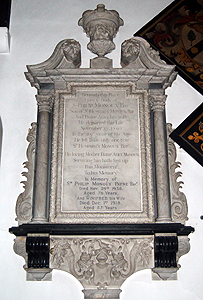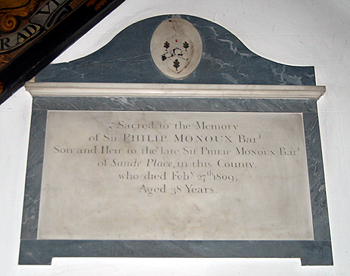The Monoux Family

The Monoux family coat of arms
George Monoux, alderman and citizen of London, purchased the Manor of Wootton called Bosoms in 1514. On 4th August 1524 Monoux bought the manors of South Anston, North Anston and Herthill, all in South Yorkshire, from William Pierrepoint for £600. By 29th April 1526 Pierrepoint had sold to Monoux the Manor of Gonalston [Nottinghamshire] and the advowson of the parish church. George Bosworth, in his George Monoux: the Man and His Work, published by Walthamstow Antiquarian Society in 1927 noted that Monoux also owned land in at least ten counties at one time of another during his life.
George Monoux died on 9th February 1543 and, as he had no issue, his estates, including Wootton, passed to his eldest brother Humphrey. It is suggested that Lewis Monoux (died 1628) was the first member of the family to live at Wootton. His mother Ann was buried there in 1608, but she may well have come to live with her son when her husband died in 1585. Lewis’ sister married at Wootton in 1618.
The Monoux estate in Wootton at the death of Lewis consisted of the Manor of Bosoms, four messuages (houses in single occupation), six tofts of land, twenty acres of meadow, sixty acres of woodland and ten acres of furze (land planted with furze bushes) according to an inquisition post mortem of 7th August 1629 taken to establish the extent of Lewis Monoux’s holdings after his death [F622]. The capital messuage, or mansion, of the manor was probably Bourne End Farm [AD2636].
On Lewis Monoux’s death the Wootton estate passed to his son Humphrey (died 1675). He was created a baronet on 4th December 1660. Sir Humphrey greatly extended his Bedfordshire estates, especially in Wootton. Sometime between 1639 and 1666 he purchased the Manor of Wootton, formerly owned by Lord Carlisle, which included the site of the present Wootton House. Sir Humphrey was buying land in nearby Berry Field in the 1650s and the house was probably built shortly afterwards as a seat worthy of a new baronet.
![Wootton House about 1920 [PK1/7/13]](/CommunityHistories/Wootton/WoottonImages/Wootton House about 1920 PK1-7-13.jpg)
Wootton House about 1920 [PK1/7/13]
Humphrey’s son was also called Humphrey (1640-1685) and on 10th July 1666 he married Alice Cotton of Cunnington [Huntingdonshire]. Part of the stipulations of the marriage settlement was that two separate sums of £5,000 and £4,000 should be paid out to buy property to enhance the value of the estate [AD2636]. In 1669 several lands belonging to the Manor of Cardington were purchased for £3,000 [X53/108 and AD2496-2497]. More important was the purchase of the Manor of Sandy in 1670. This also included the advowson of Sandy Rectory.

Monument to Sir Humphrey Monoux (died 1685)
Humphrey succeeded to the family estates on the death of his father in 1675. The second baronet added the valuable Broom estate in the parish of Southill. He probably bought the Stanford Estate, also in Southill, around the same time. Humphrey was elected member of parliament for Bedfordshire in the Whig interest and served from 1679 to 1685. The enhanced value of their estates was clearly making the Monoux family a force to be reckoned with locally.
Yet, the family’s potential was not fulfilled. In the thirty eight years after the death of Humphrey, second baronet, in 1685, for only eight of them was the estate owner not a minor. Humphrey’s son Philip came of age about 1699 and only lived until 1707. Not surprisingly there was little alteration to the estate until Philip’s son Humphrey came of age in 1723. An Act of Parliament allowed the executors of Sir Philip to sell the Broom Estate in 1709.

Monument of Sir Philip Monoux 3rd Baronet on the south wall of the chancel June 2012
Sir Humphrey, 4th baronet, lived at Wootton House but only bought two closes in Hall End to add to the Wootton Estate. His main purchases were in Sandy, particularly in the 1720s and 1730s. These included some exchanges with the junior branch of the family. Sir Humphrey’s had Jacobite sympathies, in other words, he felt that the Roman Catholic Prince Charles Edward Stuart, “Bonnie Prince Charlie” had a valid claim to the English throne. These sympathies meant that he played no prominent part in local politics as they verged on treason, particularly in the light of the prince’s invasion in 1745.

Monument to Sir Philip Monoux in the chancel June 2012
On Sir Humphrey’s death without issue in 1757 the estate passed to the junior branch of the family in the person of Sir Philip Monoux (died 1805). Philip was the grandson of Lewis Monoux (1650-1720), younger son of the first baronet. Sir Philip thus united his own considerable estates in Wootton and Sandy with the senior branch’s holdings in exactly the same parishes.
Lewis was left the Manor of Cranfield on his father’s death in 1675. A lawyer at Gray’s Inn, he did not start buying extensively until the 1690s. He purchased the parsonage of Wootton and probably at least three farms in Sandy. His son Humphrey (1702-1752) bought a couple of closes of pasture in Bott End in Wootton. It was in Sandy that his main efforts were concentrated. He added at least four farms, several cottages and numerous pieces of arable land in the extensive common fields in the parish. A number of Humphrey’s lands were gained by exchange with the senior branch of the Monoux family. Most unfortunately, the deeds of the land received by the junior branch from these exchanges do not appear to have survived. Humphrey’s seat, Sandye Place, was probably built on one of these pieces of exchanged land. In 1736 Humphrey was living at the early eighteenth century Sandy Rectory. Sandye Place is dated, on architectural grounds, to the 1740s. His brother, Lewis (1704-1771), continued to live at the Rectory. He had been presented to the living of Sandy on 5th December 1729.
Sir Philip only purchased Little Studleys Close in Wootton after he inherited both estates. In Sandy the estate was extended with the exchange of a cottage here or a piece of common field there. Sir Philip had four daughters. His only surviving son, Philip, died only four years after his father. The death of Philip the elder’s first cousin, also, inevitably, called Philip, brought the baronetcy to an end in 1812.

Monument to Sir Philip Monoux the younger in the chancel June 2012
In 1810 Sir Philip’s four daughters divided the Monoux estates between themselves expectant on the death of the Sir Philip who died in 1812. The eldest was Mary, widow of Sir John Payne and later wife of Joseph Francis Buckworth. She inherited the major part of the Wootton Estate, including Wootton House itself. The rest went to her sister Lucy. She also received a farm at Kempston Hardwick, land at Cardington and Turvey.The Manor of Sandy went to Frances Ongley [F643]. The fourth sister, Judith, wife of Richard Franklin of Great Barford inherited the Gonalston Estate.
For information about the archives relating to the Monoux family held here at Bedfordshire Archives and their interrelationship with the Payne and Doyne-Ditmas archives, see this article.